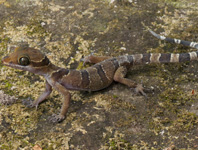Abstract
The bent-toed geckos of the genus Cyrtodactylus are the most speciose land vertebrates of Southeast Asia (about 300 species so far) and new species continue to be recognized at a rapid rate. Within the last decade three new species were described from Java, Indonesia, C. semiadii, C. petani, and C. klakahensis. The latter two are very similar, except for differences in the precloacal depression in adult males. These two species have relatively close type localities, separated from each other by only about 50 km, and with similar habitat type and elevation. Our study aimed to evaluate the taxonomic status of C. klakahensis and C. petani using both morphological and genetic evidence. These two species are genetically similar, with a genetic divergence of only 1.5 to 1.6%. This divergence is well below the level of typically characterizes sister species of Cyrtodactylus (approximately 4% in the mitochondrial ND2 gene), and is more in line with population variation due to geographic distance. Further examination of specimens, from both type localities, showed no diagnostic morphological characters between the two species. Thus, we conclude that C. klakahensis and C. petani are conspecific, and following article 23 of the ICZN, C. klakahensis is herein considered a junior synonym of C. petani.
References
Grismer, L.L., Wood, P.L. Jr., Quah, E.S.H., Muin, M.A., Sumontha, M., Ahmad, N., Bauer, A.M., Wangkulangkul, S., Grismer, J.L. & Pauwels, O.S.G. (2012) A phylogeny and taxonomy of the Thai-Malay Peninsula Bent-toed Geckos of the Cyrtodactylus pulchellus complex (Squamata: Gekkonidae): combined morphological and molecular analyses with descriptions of seven new species. Zootaxa, 3520 (1), 1–55.
https://doi.org/10.11646/zootaxa.3520.1.1
Grismer, L.L., Wood, P.L.Jr., Thura, M.K., Zin, T., Quah, E.S.H., Murdoch, M.L., Grismer, M.S., Lin, A., Kya, H. & Win, N. (2018) Twelve new species of Cyrtodactylus Gray (Squamata: Gekkonidae) from isolated limestone habitats in eastcentral and southern Myanmar demonstrate high localized diversity and unprecedented microendemism. Zoological Journal of the Linnean Society, 182, 862–959.
https://doi.org/10.1093/zoolinnean/zlx057
Göltenboth, F., Schiemer, F., Bretschko, G. & Timotus, K.H. (1996) Tropical Limnology. The Story of the German Sunda Limnoloical Expedition of 1928–1929 as presented by original pictures. Tropical Limnology. Satya Wacana University Press, Salatiga, 173 pp.
Hadi, A.K. (2016) Migrasi orang-orang Madura ke Jawa Timur 1870–1930. Skripsi Fakultas Ilmu Sosial, UNY, Yogyakarta. Available from: https://eprints.uny.ac.id/30541/ (accessed 20 July 2020)
Hartmann, L., Mecke, S., Kieckbusch, M., Mader, F. & Kaiser, H. (2016) A new species of bent-toed gecko, genus Cyrtodactylus Gray, 1827 (Reptilia: Squamata: Gekkonidae), from Jawa Timur Province, Java, Indonesia, with taxonomic remarks on C. fumosus Müller, 1895. Zootaxa, 4067 (5), 552–568.
https://doi.org/10.11646/zootaxa.4067.5.2
Harvey, M.B., O’Connell, K.A., Barraza, G., Riyanto, A., Kurniawan, N. & Smith, E.N. (2015) Two new species of Cyrtodactylus (Squamata: Gekkonidae) from the Southern Bukit Barisan Range of Sumatra and an estimation of their phylogeny. Zootaxa, 4020 (3), 495–516.
https://doi.org/10.11646/zootaxa.4020.3.5
Hillis, D.M. & Bull, J.J. (1993) An empirical test of bootstrapping as a method for assessing confidence in phylogenetic analysis. Systematic Biology, 42, 182–192.
https://doi.org/10.1093/sysbio/42.2.182
International Code of Zoological Nomenclature [ICZN] (1999) International Code of Zoological Nomenclature. 4th Edition. International Trust for Zoological Nomenclature, London, 306 pp.
Kumar, S., Stecher, G., Li, M., Knyaz, C. & Tamura, K. (2018) MEGA X: molecular evolutionary genetics analysis across computing platforms. Molecular Biology and Evolution, 35, 1547–1549.
https://doi.org/10.1093/molbev/msy096
Mecke, S., Kieckbusch, M., Hartmann, L. & Kaiser, H. (2016) Historical considerations and comments on the type series of Cyrtodactylus marmoratus Gray, 1831, with an updated comparative table for the bent-toed geckos of the Sunda Islands and Sulawesi. Zootaxa, 4175 (4), 353–36.
https://doi.org/10.11646/zootaxa.4175.4.5
Miller, M.A., Pfeiffer, W. & Schwartz, T. (2010) Creating the CIPRES Science Gateway for inference of large phylogenetic trees. In Proceedings of the Gateway Computing Environments Workshop (GCE), New Orleans, Louisiana, 14 November 2010, pp. 1–8.
https://doi.org/10.1109/GCE.2010.5676129
Oliver, P.M., Richards, S.J. & Sistrom, M. (2012) Phylogeny and systematics of Melanesia’s most diverse gecko lineage (Cyrtodactylus, Gekkonidae, Squamata). Zoologica Scripta, 41, 437–454.
https://doi.org/10.1111/j.1463-6409.2012.00545.x
Oliver, P.M., Richards, S.J., Mumpuni & Rösler, H. (2016) The Knight and the King: two new species of giant bent-toed gecko (Cyrtodactylus, Gekkonidae, Squamata) from northern New Guinea, with comments on endemism in the North Papuan Mountains. ZooKeys, 562, 105–130.
https://doi.org/10.3897/zookeys.562.6052
Puillandre, N., Lambert, A., Brouillet, S. & Achaz, G. (2012) ABGD, automatic barcode gap discovery for primary species delimitation. Molecular Ecology, 21, 1864–1877.
https://doi.org/10.1111/j.1365-294X.2011.05239.x
Riyanto, A., Grismer, L.L. & Wood, P.L. Jr. (2015) The fourth Bent-toed Gecko of the genus Cyrtodactylus Squamata: Gekkonidae from Java, Indonesia. Zootaxa, 4059 (2), 351–363.
https://doi.org/10.11646/zootaxa.4059.2.6
Riyanto, A., Munir, M., Martamenggala, A.S., Fitriana, Y.S. & Hamidy, A. (2019) Hiding in plain sight on Gunung Muria: A new species and first record of rock gecko (Cnemaspis Strauch, 1887: Squamata: Gekkonidae) from Java, Indonesia. Zootaxa, 4608 (1), 155–173.
https://doi.org/10.11646/zootaxa.4608.1.9
Ronquist, F. & Huelsenbeck, J.P. (2003) MrBayes 3: Bayesian phylogenetic inference under mixed models. Bioinformatics, 19 (12), 1572–1574.
https://doi.org/10.1093/bioinformatics/btg180
Sambrook, J., Fritschi, E.F. & Maniatis, T. (1989) Molecular cloning: a laboratory manual. 2nd Edition. Cold Spring Harbor Laboratory Press, New York, 1626 pp.
Stamatakis, A. (2014) RAxML version 8: a tool for phylogenetic analysis and post-analysis of large phylogenies. Bioinformatics, 30 (9), 1312–1313.
https://doi.org/10.1093/bioinformatics/btu033
Wilcox, T., Zwick, D., Heath, T. & Hillis, D. (2002) Phylogenetic relationships of the dwarf boas and a comparison of Bayesian and bootstrap measures of phylogenetic support. Molecular Phylogenetics and Evolution, 25, 361–371.


